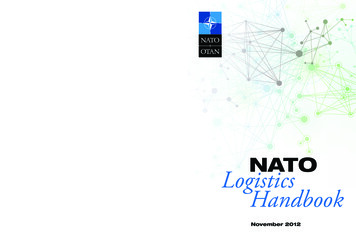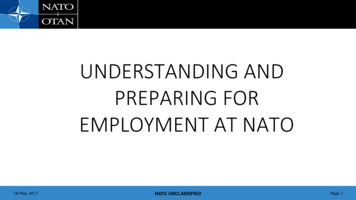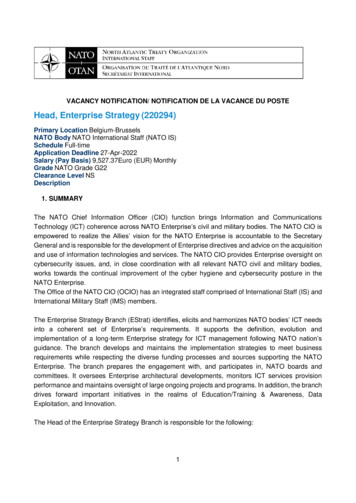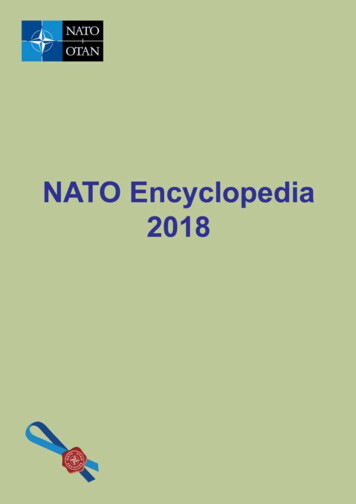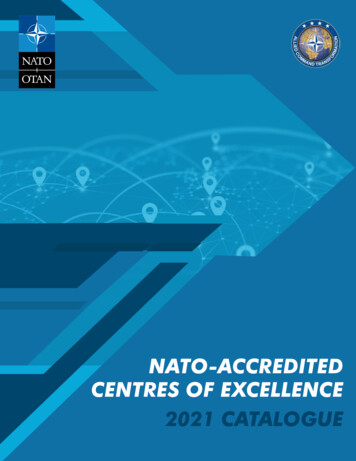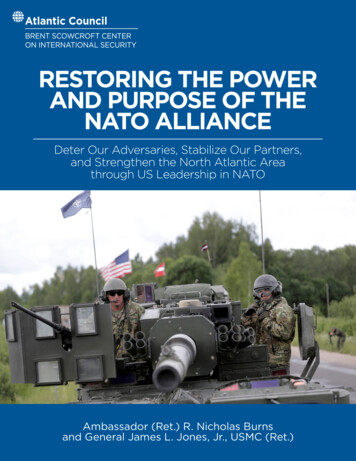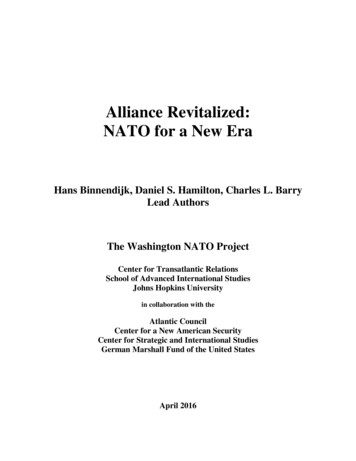
Transcription
Alliance Revitalized:NATO for a New EraHans Binnendijk, Daniel S. Hamilton, Charles L. BarryLead AuthorsThe Washington NATO ProjectCenter for Transatlantic RelationsSchool of Advanced International StudiesJohns Hopkins Universityin collaboration with theAtlantic CouncilCenter for a New American SecurityCenter for Strategic and International StudiesGerman Marshall Fund of the United StatesApril 2016
Table of ContentsPreface and Acknowledgments . . .iiiHeadline Summary.ivExecutive Summary vAlliance Revitalized: NATO for a New Era . .1I.Ends: Strategies for the East, North and South.3II.Ways: A Top Ten for NATO.91. Build “Full Spectrum” Deterrence and Defense2. Enhance Defense and Deterrence in NATO's East3. Be Prepared for Immediate Deployments in extremis4. Meet Anti-Access Area Denial (A2/AD) Challenges5. Refocus NATO’s Maritime Capabilities6. Maintain Nuclear Deterrence7. Enhance NATO'S Core Task of Crisis Management8. Maximize Resilience9. Bolster NATO’s Cyber Defenses10. Create Continuous Strategic AwarenessIII.Means: Four Paths to Deliver Capabilities . .281. Match Means to Missions2. Develop Stronger Framework Nation Concepts3. Facilitate Innovation4. Strengthen PartnershipsAbout the Authors . .38Photo Credits . . .40Endnotes . .40ii
Preface and AcknowledgementsIn fall 2015 and winter 2016 five U.S. think tanks, under the leadership of the Center forTransatlantic Relations (CTR) at Johns Hopkins University’s Paul H. Nitze School of AdvancedInternational Studies (SAIS), engaged in a process to generate new ideas and thinking about thetransatlantic community's role in a changing global security environment and to spark debatebefore and after NATO's Warsaw summit in July 2016. In collaboration with the AtlanticCouncil, the Center for a New American Security (CNAS), the Center for Strategic andInternational Studies (CSIS), and the German Marshall Fund of the United States (GMF), thisinitiative became known as the Washington NATO Project.Over the past nine months the five think tanks have solicited views on NATO’s future fromscores of current and former government officials and military leaders, legislators, think tankcolleagues, scholars and other experts from both sides of the Atlantic. Four major conferencesexamined specific issues. The first conference, co-hosted by CSIS and the Atlantic Council of theUnited States, focused on threats and challenges to NATO's north and east, and on collectivedefense. The second conference, hosted by the German Marshall Fund of the United States andthe Center for a New American Security, together with the Embassy of Italy, focused on threatsand challenges to NATO's south and southeast, and on crisis management. The third conference,hosted by the SAIS Center for Transatlantic Relations and NATO's Allied CommandTransformation (ACT), together with the Royal Netherlands Embassy, focused on defensecapabilities, cooperative security, and NATO transformation. A final conference series in theUnited States and Europe featured our conclusions and recommendations, in partnership with thePolish NATO Summit team.We wish to thank those mentioned above for helping to sponsor our deliberations, and the manyEuropeans and Americans who engaged in the discussions. We are grateful to the NorwegianMinistry of Defense and the Norwegian Institute of Defense Studies under the auspices of theSecurity and Defense in Northern Europe Project as well as the Embassy of Denmark for itsgenerous intellectual and financial support for the first conference, the Embassy of Italy for itssupport to the second conference, the Royal Netherlands Embassy for its support to the thirdconference, and the Embassy of Poland and the Polish government for their support to the finalconference series. We are grateful to Derek Chollet, Heather Conley, Mariette Hägglund, RobertHunter, Steven Keil, Frank Kramer, Magnus Nordenman, Heidi Obermeyer, Rachel Rizzo,András Simonyi, Julianne Smith, Kurt Volker and others who remain anonymous for helpfulinsights.The views we express are our own, however, and do not necessarily reflect those of ourinstitutions, our sponsors, officials of any government, or anyone participating in our discussions.Not all members of The Washington NATO project would adhere to every formulation orargument. We do not claim to have found all the right answers. But we hope we have raised someof the right questions.iii
Headline SummaryThe NATO Alliance faces simultaneous dangers to its east, to its south, and from a series ofsecurity challenges unbounded by geography, at a time when disparate allied responses to a hostof challenges are tearing the seams of European unity and American political figures have evenquestioned the need for NATO. Europe risks turning from an exporter of stability to an importerof instability. The vision of a Europe whole, free and at peace is challenged by a Europe fracturedand anxious.The Alliance must be revitalized for the new world rising before us. An overarching Alliancestrategy must rely on NATO's ability to provide a full spectrum of deterrent and defense tools toprovide collective defense for all of its members, together with an ability to project stability andresilience beyond its borders using an array of tools for crisis management. Looking to the July2016 Warsaw Summit and beyond, we offer the following recommendations.Ends: Strategies for the East, North and the South Advance a Three-Track Russia Policy: Western nations should act to deter Russia wherenecessary; maintain continuous communication and interact selectively with the regimewhere useful; and engage actively with the broadest range of Russian societal actors aspossible. Conduct a High-Level Arctic Review to address security challenges in the region. Initiate a Southern Strategy of ''Comprehensive Support'' that should include NATO supportfor lead nation and coalition operations; collective defense incorporating missile and airdefenses and new maritime approaches; continued investment in NATO's Readiness ActionPlan; crisis management capabilities; closer NATO-EU ties; strengthened regional partners;and focus on deterrence and defense measures, particularly along the Turkish-Syrian border.Ways: A Top Ten for NATOFor the past 20 years NATO's mantra has been ''out of area or out of business.'' Today'smantra must be ''in area or in trouble.'' NATO must:1. Build “full spectrum” deterrence and defense as the keystone of the Warsaw Summit.2. Move beyond the Readiness Action Plan to enhance defense and deterrence in NATO's east.3. Be prepared for immediate deployments in extremis.4. Meet anti-access area denial (A2/AD) challenges.5. Refocus NATO’s maritime capabilities on collective defense and flexible deployments.6. Maintain nuclear deterrence and continue apace with missile defenses.7. Enhance NATO'S core task of crisis management.8. Maximize resilience.9. Bolster NATO’s cyber defenses.10. Create continuous strategic awareness and procedures for rapid decision-making.Means: Four Paths to Deliver CapabilitiesIf NATO is to reform along the lines we propose, it must:1. Match means to missions.2. Develop stronger Framework Nation concepts to drive smart defense and encourage rolespecialization by design.3. Facilitate innovation.4. Strengthen partnerships.iv
Executive SummaryThe NATO Alliance faces simultaneous dangers to its east, to its south, and from a series ofsecurity challenges unbounded by geography. Allies have taken important steps, including at the2014 Wales Summit, to adapt NATO to deal with these multiple challenges. Additional initiativesare being planned for the 2016 Warsaw Summit. Yet incremental improvements cannot maskgrowing fissures within the Alliance, particularly between those focused on dangers from the eastand those focused on dangers from the south. This divergence in priorities needs to be overcomerapidly, because the east vs. south dichotomy is a false one. The unfortunate reality is that bordersand principles are being tested both to Europe's east and to its south, and the dangers of eachregion have great potential to come together in ways that can directly threaten Europeans,Americans and many others around the globe.Moreover, these external dangers may prove to be less consequential than mounting internaldangers to Alliance cohesion. Disparate responses to a host of simultaneous challenges are tearingthe seams of European unity. Mutual doubts gnaw at allied commitments to collective defenseand mutual security. Questions about the future of the Alliance have been voiced during theAmerican presidential campaign.These forces risk turning Europe from an exporter of stability to an importer of instability. Thevision of a Europe whole and free is being tested by a Europe fractured and anxious.Europe’s internal challenges have now become a critical strategic problem for the United Statesand the West as a whole. The transatlantic partnership and the NATO Alliance remainindispensable if Western countries are to tackle effectively the challenges they face. A weakertransatlantic bond would render Americans and Europeans less safe, less prosperous, and lessable to advance either their ideals or their interests in the wider world. A weakened or destroyedAlliance would hand victory to Russia and to Daesh -- the Arabic acronym for the so-calledIslamic State. The Warsaw Summit will need to address this issue and state in the clearest termsthe continued importance of the Alliance to all transatlantic partners.NATO is the preeminent institutional expression of the transatlantic bond. It must be retooled forthe new world rising before us. Once a newly elected U.S. administration is in place, NATO alliesshould tune their Strategic Concept to new times. Looking to the July 2016 Warsaw Summit andbeyond, we offer the following recommendations, some of which are under debate, yet notnecessarily resolved, within the Alliance. We believe that greater public understanding of theseinitiatives can generate support for a revitalized Alliance.Ends: Strategies for the East, North and the SouthAdvance a Three-Track Russia Policy. Russia policy begins at home. Putin's challenge is as much about the West as it is aboutRussia. If we stand up for our values and give fresh life to our mutual commitments,including mutual defense and deterrence through NATO, we are likely to be more successfulin our approach to Russia. Some argue that such demonstrations of strength would beprovocative. We believe Western weakness would be more provocative. At the same time,maintaining a close dialogue with Russia remains critical as both sides upgrade theirdefenses. Conflict due to accident, misinterpretation, or miscalculation remains a realpossibility; constant dialogue will be needed to prevent it.v
Grounded in the policies we recommend in this report, we believe that Western policytoward Russia must be proceed along three parallel and mutually reinforcing tracks: Deterring Russia where necessary; Continuous communication and selective engagement with the regime where useful; Proactive Western engagement with the broadest range of Russian societal actors aspossible.Conduct a High-Level Arctic Review to consider how to strengthen maritime capabilities inthe Arctic; update NATO contingency plans for its northern flank; incorporate a heightenedfocus on information sharing and surveillance; engage capable and committed partners likeSweden and Finland to address deficiencies in sea, air, and land assets; address the potentialconsequences of increased militarization in the Arctic through training and exercises, andenhance EU-NATO cooperation in the region.Initiate a Southern Strategy of ''Comprehensive Support'' that recognizes the limits ofNATO’s ability to affect outcomes and very real resource constraints. The Alliance must rethinkits partnerships and look beyond security tools to a more comprehensive and flexible strategy thatshould include: NATO support for lead nation and coalition operations undertaken by NATO members inthis unstable region; Collective defense incorporating missile and air defenses and new maritime approaches; Continued investment in NATO's Readiness Action Plan, especially the Very HighReadiness Joint Task Force (VJTF) and exercising its use for southern contingencies; Crisis management capabilities such as Special Operations Forces, counter insurgency andaircraft designed for no-fly zones, all as part of NATO's comprehensive approach; Closer NATO-EU ties to address the confluence of terrorism, migrant flows, state collapseand general instability from the south and, should such cooperation prove infeasible, NATOefforts to complement the work of coalitions involving NATO and non-NATO countries; Strengthening regional partners such as Israel, Jordan, Morocco and Tunisia, andpartnerships with the Gulf Cooperation Council and the African Union; Reinforcing Article 4 of the North Atlantic Treaty and NATO's political elements, includingserving as a platform of dialogue among like-minded countries; Focusing on deterrence and defense measures, particularly along the Turkish-Syrian border.NATO’s strategies towards the east, north and south can be consolidated into an overarchingstrategy that covers all three areas. This might be accomplished in at least two ways. First, in all three cases, NATO’s purpose must be to provide a full spectrum of deterrent anddefense tools to provide collective defense for all of its members. Second, NATO seeks to project stability and resilience beyond its borders using an array oftools for crisis management.Taken together, Full Spectrum Defense and Projecting Stability provide a solid core for allNATO’s operations.Ways: A Top Ten for NATO1. Build “Full Spectrum” Deterrence and Defense as the Keystone of the Warsaw Summit. For the past 20 years NATO's mantra has been ''out of area or out of business.'' Today'smantra must be ''in area or in trouble.'' NATO must be able to dissuade and deter threats to its members, from whateversource and across all domains, while being prepared to defend all parts of NATOvi
territory and to protect the critical functions of allied societies. It must be designed todeal with the full panoply of provocations, from low-level hybrid tactics throughnuclear blackmail. This requires a mix of new and old deterrent and defense instruments that can beapplied 360 degrees around NATO’s borders and in all NATO countries. NATO willrequire the Alliance to better relate deterrence and defense to resilience, to work moreeffectively with other partners, and to become more agile, flexible, mobile, andcreative. The remaining nine initiatives are designed to provide capabilities for a full spectrumfor defense and deterrence. Building these capabilities will take time but plans to doso can build assurance and enhance unity in the Alliance now.2. Move beyond the Readiness Action Plan to Enhance Defense and Deterrence in NATO'sEast. Deterrence by denial is impractical and deterrence by mobilization of high readiness forcesalone is inadequate. NATO will need to develop a modest but adequate forward deployedforce to create a credible signal of resolve that the Alliance will defend all Alliance territoryand will fight to retake any NATO territory lost. Assure that the high readiness forces agreed at the Wales Summit are fully deployable onvery short notice. Forward deploy multinational NATO forces in the Baltic region on a rotational basis, startingwith a Multinational Battalion in each of the Baltic states and in Poland. Preposition adequate equipment and war fighting stocks for the VJTF and for European andAmerican follow on forces needed to defeat a Russian attack and restore lost NATO territory. Encourage the move towards the deployment of four U.S. Brigade Combat Teams in Europe(two permanently deployed, a third on a heel-to-toe rotational basis in the east, and a fourthbased initially in the U.S. with prepositioned stocks plus rigorous exercising in Europe), anddeployment of 1-2 U.S. Attack Helicopter battalions in Europe. Develop current air policing into a NATO rotational air component composed of air fighterand combat helicopter wings. Additional NATO capabilities, such as a Joint Force AirComponent, should be considered for Poland. Make frontline states indigestible, so that they do not become indefensible, via expandedcapacities to conduct irregular defense.3. Be Prepared for Immediate Deployments in extremis. Set specific targets for the readiness of NATO national forces similar to the targets set fordeployability and sustainability. Develop a U.S. follow on capability to deploy an additional reinforced division in ten days. Draft a U.S. mobilization plan to reinforce Europe in the event of general war. Assure that European forces can contribute significantly to a reinforcement effort. Individual NATO Allies may want and be able to deploy high-readiness forces to vulnerableAllied countries when needed, even before the North Atlantic Council has had theopportunity to reach consensus to respond in an urgent situation. Such plans should beconsistent with those of NATO and SACEUR. Strengthen NATO’s ability to deploy, sustain and provide logistics and host nation supportfor follow on forces. Authorize SACEUR to conduct extensive scenario planning that can driveNATO/nations’ military efforts, and unclassified modeling to inform NATO publics.vii
Consider further delegation of authority to the Secretary General and SACEUR tomake decisions on alerting, exercising and pre-deployment actions, in response toRussian military threats.East European Allies need to offer the necessary host-nation support and provide thelegal and institutional framework for such rapid stop-gap reinforcement.Efforts to remove legal and other barriers to mobilization across national boundariesneed to be accelerated; a “military Schengen zone” is needed that can be activated attimes of exercise or emergency.4. Meet Anti-Access Area Denial (A2/AD) Challenges. A higher degree of European allied cooperation and participation will be needed to meet thischallenge; the United States cannot conduct these operations by itself. Efforts to apply extra resources to meet the Priority Shortfall Areas agreed within theAlliance should help with this initiative. Allies should not view these challenges through a narrow military lens alone. They need to beable to calibrate responses and manage escalation as part of a more strategic and sophisticatedapproach that should involve a wider spectrum of options, ranging from defensive maritimeblockades and cyber activities to political and offensive actions. This does not mean ignoring military options. Pay greater attention to integrated air andmissile defenses, long-range artillery, stealthy air-to-air and air-to-ground systems,submarines and anti-submarine warfare, offensive cyber-weapons and short-range missiles,directed-energy and electromagnetic rail guns, counter-space and Intelligence, Surveillanceand Reconnaissance (ISR) capabilities. Experimental concepts and technologies in the context of the United States' so-called ''ThirdOffset Strategies'' are relevant.5. Refocus NATO’s Maritime Capabilities on Collective Defense and Flexible Deployments. Revise the Alliance Maritime strategy to better focus Alliance efforts on collective defenseand deterrence in the maritime domain. Strengthen the existing Standing NATO Maritime Groups and generate adequate forces forthem to deliver on that strategy. Generate a robust, well-resourced maritime component for the VJTF. Focus on high-end maritime capabilities including anti-submarine warfare, surface warfare,strike from the sea, amphibious operations, and integrated theater missile defense. Consider how maritime forces can become more survivable and contribute to breakingA2/AD capabilities. Create a NATO Black Sea fleet composed primarily of regional allies and perhaps anAmerican contribution. Create a NATO consortium to enhance maritime domain awareness that would draw togetherand pool national assets ranging from maritime patrol aircraft, unmanned systems, aerostatsand underwater sensor chains and radars. Map Alliance and member state dependencies on undersea pipelines, electrical cables andcommunications infrastructure, from landing points to deep seabed routes. Design plans tomonitor and defend, and to operate in degraded environments. Organize frontline maritime powers to provide a “first response” capability in crisis or war. Serve as an advocate for good order at sea.viii
6. Maintain Nuclear Deterrence and Continue Apace with Missile Defenses. NATO should not try to mirror Russia’s increasingly irresponsible nuclear behavior. Instead,it should develop a clearer nuclear declaratory policy to complement the steps underway tostrengthen NATO’s conventional forces. NATO should be forthright to publics about why nuclear deterrence remains critical to thesecurity of NATO and our societies. It should acknowledge that the world without nuclearweapons that NATO seeks is not today's world, and highlight the risks and dangers ofRussia’s nuclear saber rattling. NATO should continue to reiterate its interest in reducing its reliance on nuclear weapons,but be equally clear that a reduction of the risk of nuclear weapons being used depends on awilling partner, which Russia does not appear presently to be. In addition, NATO should make five modest adjustments to its nuclear posture: Maintain and as needed modernize the existing modest NATO non-strategic nucleardeterrent deployed in Europe. Work with affected Allies to replace outmoded dual capable aircraft. Exercise potential responses to Russian nuclear threats. Better integrate NATO’s conventional and nuclear doctrine. Seek ways to integrate France more directly into NATO nuclear planning efforts,including through the Nuclear Planning Group and joint policy planning discussions. The Alliance is developing an anti-ballistic missile system to protect Allies from growingmissile threats from outside the Euro-Atlantic area. Attainment of Phase II of the U.S. PhasedAdaptive Approach (including interceptor deployments in Romania) and the completion ofthe BMD initial operational capability should be declared at the Warsaw Summit. Some haveargued that the nuclear deal with Iran removes the threat that the Phased Adaptive Approachwas designed to defeat. But Iran’s recent missile tests reinforce the continued need to keepthose plans on track.7. Enhance NATO'S Core Task of Crisis Management. The North Atlantic Council has waned as a political forum to discuss strategic issues. Thefocus on collective defense should not come at the expense of crisis management and theAlliance's responsibilities to reduce threats, and to prevent and respond to conflicts in andbeyond its immediate neighborhoods. At a skills level NATO must retain the capability to conduct scalable counter insurgency, stabilizationoperations, and the building of partner capacity. Nations should prioritize SOF capability investment even with tight budgets, and includethe funding of participation in NATO as well as bilateral and multilateral SOF exercises. NATO should continue to facilitate multinational SOF development through training,education, exercises and networking, and if called upon deploy operational command andcontrol of SOF from NATO's Special Operations Headquarters. NATO should actively seek to maximize the civilian-military integration capabilities ofthe new Comprehensive Crisis Operations and Management Center (CCOMC) atSHAPE. At an operational level the Resolute Support Mission in Afghanistan should be sustained, with maximumEuropean support, to give Afghanistan every possible chance to succeed in its fightagainst the Taliban; NATO should take the lead role in training Iraqi and other forces for the fight againstDaesh;ix
NATO should also take on a major security sector and capacity building mission inLibya.At a political level NATO should reinvest in meaningful strategic consultations on a wide range of globalsecurity challenges – whether or not there is the prospect of NATO taking on anoperational role. The North Atlantic Council should play a vital role in sharing information, analysis, andpolicy perspectives among Allies on an ongoing basis, on a wide range of issues. Closer consultations between NATO and the U.S. led anti-Daesh coalition should be a keyelement in restoring NATO’s role as a political forum for crisis management issues. NATO's ministerial meetings should be revamped to ensure that they can take strategicdecisions. When NATO does elect to take action, it should identify a time when the operation will bereviewed and require new authorization by the North Atlantic Council, to ensureengagements continue to enjoy Allied support, without becoming long-term, open-endedmissions.8. Maximize Resilience. Traditional efforts at deterrence and defense must incorporate modern approaches toresilience -- building the capacity of societies to anticipate, preempt and resolve disruptivechallenges to their critical functions, the networks that sustain them, and the connectionsthose networks bring with other societies. Resilience is foremost a task for national governments. Yet in an age of potentiallycatastrophic terrorism, networked threats and disruptive hybrid attacks, no nation is homealone. Emerging challenges require greater shared resilience. National resilience andcollective defense must be mutually reinforcing elements of the same overall effort toenhance deterrence. Resilience requires a broad approach with significant civilian political and economic aspects.But it also has major military components. National forces should be primary, but uponrequest NATO allies can assist, for example, with protection of key societal nodes, counterinsurgency operations and paramilitary police functions, responses to civil emergencies,covert operations and crisis response management. NATO should set resilience standards and individual allies should each make a Pledge onNational Resilience to meet those standards at the Warsaw Summit pursuant to Article 3 ofthe North Atlantic Treaty, whereby allies commit to ''maintain and develop their individualand collective capacity to resist armed attack.'' Reinforce NATO's pledge with a U.S.-EU Solidarity Pledge that each partner shall act in aspirit of solidarity — refusing to remain passive — if either is the object of a terrorist attackor the victim of a natural or man-made disaster. Make resilience an integral element of NATO's core tasks, or consider making resilience afourth core task. Initial activities could include: Developing NATO civil-military Resilience Support Teams to support nationalauthorities in emergency preparedness, intelligence sharing, border control assistanceto police and military in incident management, protection for key criticalinfrastructures and support to NATO’s Cyber Response Team. Creating “National Resilience Working Groups” to coordinate defense activitieswith overlapping civil authority and private sector infrastructure functions and toprovide a key point of contact for outside assistance, including Resilience SupportTeams.x
Bolster coordination with the private sector, which owns most infrastructures critical toessential societal functions.Enhance counterterrorism cooperation to support the protection of critical infrastructure.Develop a more robust strategic communications strategy to address Russia's informationoperations.Project resilience forward by identifying—very publicly— our resiliency with that of othersbeyond the EU and NATO, and share societal resilience approaches and operationalprocedures with partners to improve societal resilience to corruption, psychological andinformation warfare, and disruptions to cyber, financial and energy networks and othercritical infrastructures, with a strong focus on prevention but also response.9. Bolster NATO’s Cyber Defenses. Recognize cyber as an operational domain and launch a voluntary NATO Cyber OperationsCoordination Center (NCOCC). If successful, the NCOCC should transition into a permanentNATO Cyber Operations Headquarters similar to the NATO SOF HQ. Provide a capability for Allied Command Operations to plan, coordinate, and de-conflictthe actions (defensive, offensive and exploitation) of Allies’ cyber forces committed toNATO operations. Establish mechanisms that allow SACEUR to call upon capable cyber Allies tocontribute cyber offensive effects when needed. Consider Mutual Cyber Standards Pledges, in which an individual Ally pledges to meetagreed cyber defense standards and NATO pledges assistance. Enhance NATO’s Computer Incident Response Capability (NCIRC) by rationalizing andnormalizing common funding, strengthening its Rapid Response Teams, and generatinggreater protection and resilience planning for critical mobile networks. Task ACT to develop a Cyber Operations Transformation Initiative to exploreopportunities for multinational training, networking, information sharing andinteroperability. Increase support to NATO’s Cooperative Cyber Defense Center of Excellence inEstonia.10. Create Continuous Strategic Awareness and Procedures for Rapid Decision-Making.NATO must address the issue of building comprehensive and integrated strategic awarenessthrough continuous and comprehensive information collection, fusion and sharing. If NATO is toacquire the ability to conduct such analysis, it must build flexible security networks with alliesand partne
II. Ways: A Top Ten for NATO NATO must address the dangers it faces by ensuring stability in the NATO region and reducing the threat of significant conflicts in and around NATO's adjacent areas in the east and south.13 NATO must enhance capabilities in the east against conventional and hybrid
